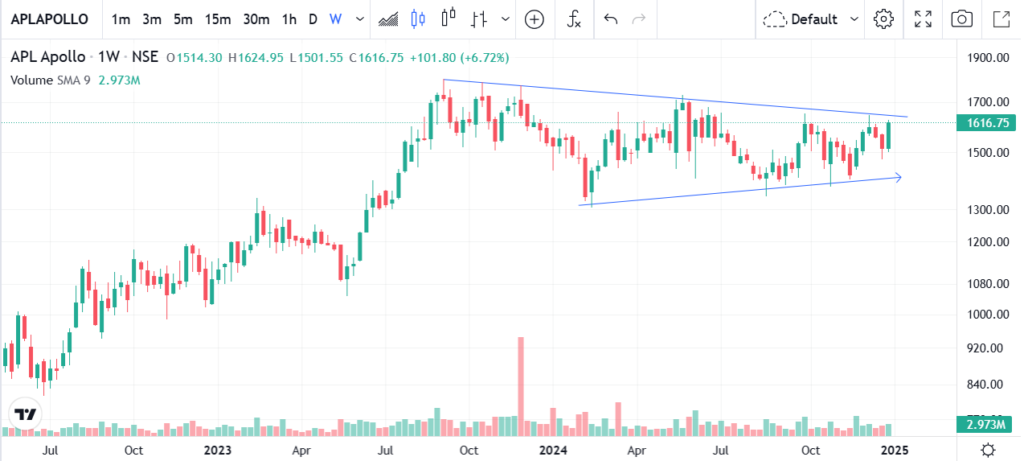We’ll start the new year with some anecdotal observations from the retail investing community.
In Aug 2023, I was one of the speakers at an offline investment summit. During the many breaks one gets during such investment summits, one can go around interacting with participants and other speakers who were presenting. One of the most discussed business groups at this summit was the APL Apollo Group. A bulk of the junta there (and many PMS funds) had loaded up on this stock through H1FY24 with the expectation that the new Raipur plant could deliver wonders over the next 12 months and spike earnings by more than 35-40%. Not just that, junta was fully loaded up on SG Finserv and SG Mart too. I distinctly remember taking a long walk with one of the other speakers there and we both agreed that the stock had priced in too much too soon. Though we weren’t too hopeful of near term performance, our (Congruence Advisers) conviction in the business for the next 3-5 years ensured that we stayed put (after communicating to our subscriber base that fair value was much lower and closer to 1350 per share than the going price of 1700 then).
What’s happened since then? Here you go….

(Disclosure: APL Apollo Tubes continues to be part of our portfolio, we added a bit more around 1350-1400 a few months ago)
Anecdotal observations and behavioral observations are good enough to get the job sometimes. That said, we believe that the stock could be poised for more interesting times over the next 12-18 months once it emerges out of the pattern at play now.
Another anecdotal observation. In August of 2024 I attended an investment summit where we had 20 speakers presenting on an idea each. Of the 20 ideas presented, 5 were from the lending sector (four NBFC’s and one bank). In the more recent online summit of December 2024 (where I presented on Paramount Communications), 20 ideas were covered on the same day. Not a single one was from the lending sector. Over the past 6 months most lenders have been beaten to a pulp, including the so called low risk, high quality HFC’s. While the stress in the microfinance, low ticket unsecured retail loans and credit cards are evident, does it warrant every lender getting beaten down irrespective of the valuation & exposure to these segments?
Think about that for a minute before you read on.
The RBI has done a reset of their growth projections for FY25. The Q2 number was expected to be below average but it turned out to be a howler. To the extent that two of the MPC members stuck their necks out in favor of a rate cut in December, after using some strong language (read minutes of the MPC here); specifically read the commentary of Dr. Nagesh Kumar and Prof Ram Singh. One of the big worries right now is that the Indian economy might get stuck in a situation of higher than wanted inflation and lower than wanted growth for a few quarters. With the lending environment being what it is, prospects of a tangible consumption improvement in urban and metro India are getting pushed further into the future. The final action to ponder over is that the Govt chose not to extend the term of the incumbent Governor who was still prioritizing inflation control over growth. Macroeconomic aggregate trends like inflation & growth take a few quarters to turn at the very least. In our assessment, it is time to be choosy and measured in portfolio actions.
This also ties into our decade old view that India is a start-stop market which warrants caution every now and then. While we will have some sectors showing secular growth for 3-5 years, at an aggregate market level it is quite difficult for things to move in a secular manner. The baton often passes from one sector to the other, one segment to another, one theme to another in a 2-3 year cycle. Even the most vocal advocates of passive investing would admit that the composition of the indices reflect this cyclicality in the Indian market (and many other markets too).
For this reason we continue to believe that active investing will have a play in India for many more years. It is just that investors need to have the guts to take the unpopular call of either avoiding a few sectors altogether or being early in a few. If one wants a market beating return, one has to keep maneuvering to where the puck is likely to be. If one makes the mistake of chasing the puck rather than being ahead of the curve, one will end up giving gyan that looks smart for some time but the medium term performance will look unimpressive. Every mini cycle of the Indian market sees some casualties – in 2018 it was one style, in 2024 it was another. Often these will be the poster boys of the previous run who are slow to recognize that the market texture is shifting and even slower to calibrate. The bigger the fund, harder the fall and the longer it takes to turn things around.
A normal market should have a healthy mix of diverse opinions with no obvious winning approach. So whenever we hear narratives like “quality will always outperform” or “small caps are the only pocket where alpha generation is possible”, we start to get uncomfortable. Once something succeeds to an extent that it becomes common knowledge, the seeds of the upcoming disaster are already being sown.
Our focus continues to remain on avoiding costly mistakes in the current market and keeping an open mind. Staying open to all possibilities and themes is easier said than done, our minds are always living in the recent past and are prone to silly extrapolation. What we mean is that we should avoid narratives like “capital goods & power sector good, consumption bad”. The only way we can reinforce this is by remembering the history of the previous decade where the narrative was “consumption good, power sector & capital goods bad”. The believers of the India capex story kept getting disappointed for years together while chaddi baniyan and footwear stocks were bid up to 60 PE in the search for earnings growth and alpha. This situation has already reversed with many core economy stocks going at 50 PE while a secular derating is underway in consumer stocks.
High entry valuation is very sneaky beast, once one goes down the slippery slope it is very difficult to turn back since the approach usually works well over the short term. Unless one can quickly and decisively cut positions, demanding a reasonable entry valuation is a more durable medium term strategy.
We begin this year on a somber note while hoping that the markets will take a more sanguine turn.
Among other updates, we recently got SEBI’s approval for a corporate RA license. This pretty much clears the path for us to launch new offerings and run differentiated smallcase portfolios for those who would prefer to also have an execution pathway in place. We will be announcing this once we get the initial compliance setup and a few other operational aspects in place, this should happen sooner than later. Hopefully by February, we will be able to bring more offerings and website features to the table. Do stay subscribed for more microcap business research notes in the meanwhile.

